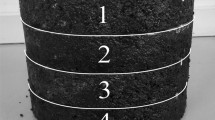Abstract
This work presents a repeatable semi circular bending (SCB) fracture test to evaluate the low temperature fracture resistance of asphalt mixture. The fracture resistance of six asphalt mixtures, which represent a combination of factors such as binder type, binder modifier, aggregate type, and air voids, and two testing conditions of loading rate and initial notch length, was evaluated by performing SCB fracture tests at three low temperatures. Fracture energy was calculated from the experimental data. Experimental results indicated strong dependence of the low temperature fracture resistance on the test temperature. Experimental plots and low coefficient of variation (COV) values from three replicates show a satisfactory repeatability from the test. The results of the analysis showed that fracture resistance of asphalt mixtures is significantly affected by type of aggregate and air void content. Experimental results also confirmed the significance of binder grade and modifier type with relation to cracking resistance of asphalt mixtures. Analysis of result also indicated that both the loading rate and initial notch length had significant effect on the fracture energy at the highest test temperature, whereas the effect was strongly diluted at the two lower temperatures. No clear trend was found with the fracture peak load from either the effect of loading rate or notch length.












Similar content being viewed by others
References
Jung D, Vinson TS (1993) Low temperature cracking resistance of asphalt concrete mixtures. J Assoc Asphalt Paving Technol 62:54–92
Jackson NM, Vinson TS (1996) Analysis of thermal fatigue distress of asphalt concrete pavements. Transp Res Rec 1545:43–49
Zubeck HK, Vinson TS (1996) Prediction of low-temperature cracking of asphalt concrete mixtures with thermal stress restrained specimen test results. Transp Res Rec 1545:50–58
Zubeck HK, Zeng H-Y, Vinson TS, Janoo VC (1996) Field validation of thermal stress restrained specimen test: six case histories. Transp Res Rec 1545:67–74
American Association of State Highway Transportation Officials (AASHTO) Standard TP9-96 (2002) Method for determining the creep compliance and strength of Hot Mix Asphalt (HMA) Using the indirect tension tensile test device. Standard specification for transportation materials and methods of sampling and testing
Moavenzadeh F (1967) Asphalt fracture. J Assoc Asphalt Paving Technol 36:51–79
Raj D, Sharma MG, Anderson DA (1989) Development of fracture criterion for asphalt mixes at low temperatures. Transp Res Rec 1228:94–105
Ioannides AM (1997) Fracture mechanics in pavement engineering-the specimen-size effect. Transp Res Rec 1568:10–16
Kim KW, Hussein HME (2005) Effect of differential thermal contraction on fracture toughness of asphalt materials at low temperatures. J Assoc Asphalt Paving Technol 64:474–499
Sulaiman SJ, Stock AF (1995) The use of fracture mechanics for the evaluation of asphalt mixes. J Assoc Asphalt Paving Technol 64:500–533
Jacobs MMJ, Hopman PC, Molenaar AAA (1996) Application of fracture mechanics principles to analyze cracking in asphalt concrete. J Assoc Asphalt Paving Technol 65:1–28
Marasteanu MO, Dai S-T, Labuz JF, Li X (2002) Determining the low-temperature fracture toughness of asphalt mixtures. Transp Res Rec 1789:191–199
Li X, Marasteanu MO (2004) Evaluation of the low temperature fracture resistance of asphalt mixtures using the semi circular bend test. J Assoc Asphalt Paving Technol 73:401–426
Wagoner MP, Buttlar WG, Paulino GH (2005) Development of a single-edge notched beam test for asphalt concrete mixtures. J Test Eval 33(6):452–460
Wagoner MP, Buttlar WG, Paulino GH (2005) Disk-shaped compact tension test for asphalt concrete fracture. Soc Exp Mech 45(3):270–277
Mobasher B, Mamlouk M, Lin H (1997) Evaluation of crack propagation properties of asphalt mixtures. J Transp Eng 123(5):405–413
Hoare TR, Hesp SAM (2000) Low-temperature fracture testing of asphalt binders: regular and modified systems. J Transp Res Rec 1728:36–42
Molenaar AAA, Scarpas A, Liu X, Erkens SMJG (2002) Semi-circular bending test: simple but useful? J Assoc Asphalt Paving Technol 71:795–815
Li X-J, Marasteanu MO (2006) Investigation of low temperature cracking in asphalt mixtures by acoustic emission. Int J Road Mater, Pavement Des 7(4):491–512
Zhang Z, Roque R, Birgisson B, Sangpetngam B (2001) Identification and verification of a suitable crack growth law. J Assoc Asphalt Paving Technol 70:206–241
Birgisson B, Roque R, Page GC (2004) Performance-based fracture criterion for evaluation of moisture susceptibility in hot-mix asphalt. J Transp Res Rec 1891:55–61
Lee NK, Morrison GR, Hesp SAM (1995) Low temperature fracture of poluethylene-modified asphalt binders and asphalt concrete mixes. J Assoc Asphalt Paving Technol 64:534–574
Wagoner MP, Buttlar WG, Paulino GH, Blankenship P (2006) Laboratory testing suite for characterization of asphalt concrete mixtures obtained from field cores. J Assoc Asphalt Paving Technol 75:815–852
Huang B, Zuo G (2004) Fatigue crack characteristics of HMA mixtures containing RAP. Proceeding 5th Int. Conf. on Cracking in Pavements, RILEM, pp 631–638
Wu Z, Mohammad LN, Wang LB, Mull M (2005) Fracture resistance characterization of superpave mixtures using a semi-circular. Int J ASTM 2(3):1–15
Artamendi I, Khalid HA (2006) A comparison between beam and semi-circular bending fracture tests for asphalt. Int J Road Mater, Pavement Des 7(Special issue for EATA):63–180
RILEM Technical Committee 50-FMC (1985) Determination of the fracture energy of mortar and concrete by means of three-point bend tests on notched beams. Mat Struct 18(106):285–290
Asphalt Institute (1996) SP-2 Superpave mix design. Lexington, Kentucky
Wu KR, Chen B, Yao W, Zhang D (2001) Effect of coarse aggregate type on mechanical properties of high-performance concrete. J Cem Concr Res 31(10):1421–1425
Harvey JT, Tsai B-W (1996) Effects of asphalt content and air void content on mix fatigue and stiffness. J Transp Res Rec 1543:38–45
Acknowledgement
This research is sponsored by Federal Highway Administration National Pooled Fund Study 776. This support is gratefully acknowledged. The results and opinions presented are those of the authors and do not necessarily reflect those of the sponsoring agencies.
Author information
Authors and Affiliations
Corresponding author
Rights and permissions
About this article
Cite this article
Li, XJ., Marasteanu, M.O. Using Semi Circular Bending Test to Evaluate Low Temperature Fracture Resistance for Asphalt Concrete. Exp Mech 50, 867–876 (2010). https://doi.org/10.1007/s11340-009-9303-0
Received:
Accepted:
Published:
Issue Date:
DOI: https://doi.org/10.1007/s11340-009-9303-0




